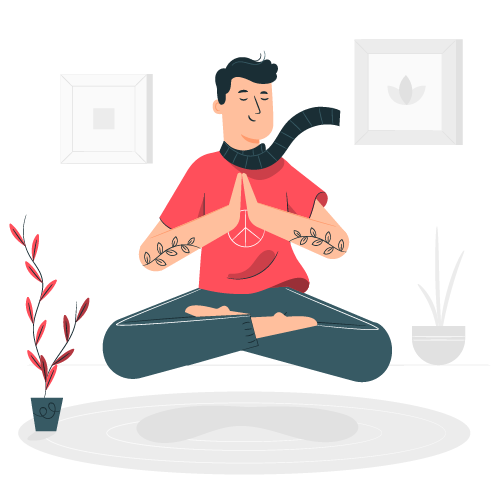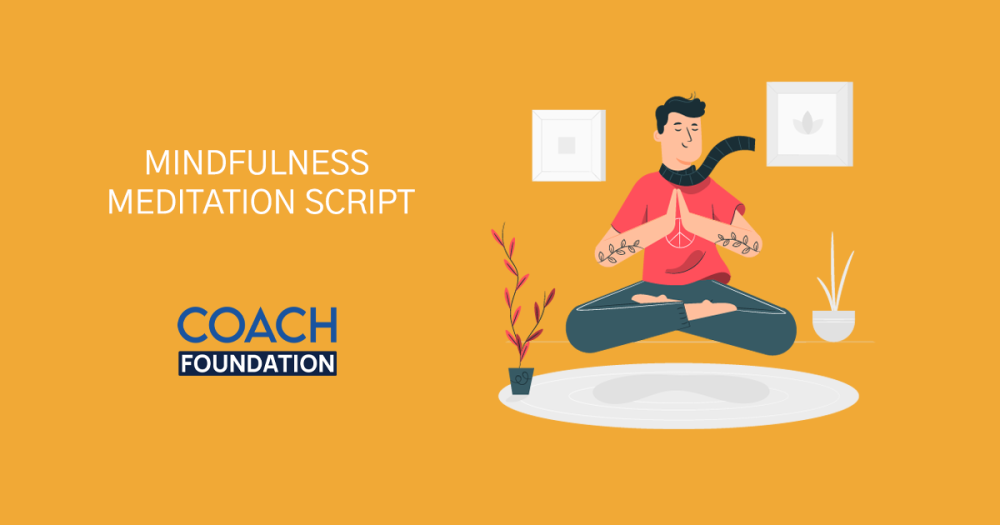Blog » Coaching Techniques » Mindfulness Meditation Script: A Step-by-Step Guide
Mindfulness Meditation Script: A Step-by-Step Guide
Are you searching for a way to bring peace and clarity into your daily life?
In the realm of mindfulness meditation, finding a script that resonates with you can be the first step toward a calmer, more mindful existence.
Whether you seek to reduce

stress, improve focus, or simply find more balance in your busy life, this article will introduce you to the power of mindfulness meditation scripts as your guiding light toward a more centered and mindful you.
So if you want to:
- delve deeper into the concept of Mindfulness Meditation
- explore its benefits
- Get practical guidance on using it effectively
- Learn about guided meditation scripts
And much more. This article is for you. Keep reading this article.
Let’s get started!
In Brief : Mindfulness Meditation Script: A Step-by-Step Guide
- ALLEVIATE STRESS WITH THREE DEEP BREATHS – Begin your meditation by taking three slow, deep breaths. Inhale deeply through your nose, filling your lungs, and exhale slowly through your mouth.
- SELF-LOVE MEDITATION – In this meditation, focus on self-compassion and acceptance. Repeat positive affirmations like “I am enough” or “I love and accept myself just as I am.”
- DROPPING THE SUITCASES OF WORRIES AND REGRETS – Visualize yourself holding heavy suitcases filled with worries and regrets. With each breath, imagine yourself letting go of these burdens.
- BODY SCAN, ADVANCED – In this meditation, scan your body from head to toe, paying close attention to any areas of tension or discomfort. With each breath, visualize these sensations melting away, leaving your body relaxed and at ease. This practice promotes physical and mental relaxation.
- BRINGING YOUR MIND BACK FROM THOUGHTS – It’s normal for your mind to wander during meditation. When you notice your thoughts drifting away, gently and without judgment, bring your focus back to your breath.
- BREATHE AWAY ANXIOUS THOUGHTS – Close your eyes and take a deep breath in, allowing the air to fill your lungs completely. As you exhale, visualize releasing any anxious thoughts, letting them float away like leaves on a gentle stream.
- AWARENESS OF EACH OF THE FIVE SENSES – Engage each of your five senses during this meditation. Take a moment to notice what you see, hear, smell, taste, and feel in your surroundings.
- FOCUSING ON THE COLORS YOU SEE – Close your eyes and visualize a calming color, such as ocean blue or forest green. Imagine this color surrounding you, enveloping you in a soothing aura of tranquility.
What is Mindfulness Meditation?
Mindfulness Meditation is a technique that encourages you to stay fully present in the moment, without judgment. It involves paying close attention to your thoughts, feelings, bodily sensations, and the world around you with open awareness.
The ultimate goal is to achieve a state of mindfulness, which can lead to reduced anxiety, better focus, and increased emotional regulation. Watch this video to go through a 10 minute guided session on mindfulness meditation.
How Mindfulness Meditation Helps Your Clients
If you are a Mindfulness Coach, you can help your clients become more aware of their thoughts and feelings. It offers a wide range of benefits which includes:
- Improved Mental Health: It can improve mental health by reducing symptoms of depression and anxiety, promoting a more positive outlook on life.
- Enhanced Focus: Mindfulness improves concentration and attention span, which can boost productivity and problem-solving skills.
- Better Emotional Regulation: Clients can learn to manage their emotions more effectively, leading to healthier relationships and self-awareness.
- Stress Reduction: Mindfulness meditation can help alleviate stress by allowing individuals to observe their thoughts and emotions without getting caught up in them.
Enhanced Self-Compassion: It encourages self-love and self-acceptance, helping clients develop a kinder relationship with themselves.
How to Use Mindfulness Meditation
To incorporate Mindfulness Meditation into your daily routine or offer it to your clients, you have to keep certain points in mind. These are the points you should follow for mindfulness meditation.
1. Find a Quiet Space:
The best place to meditate is in a quiet, comfortable space where you won’t be disturbed. It could be a cozy corner of your home, a serene park, or any place that offers tranquility.
2. Set a Time:
Decide how long you want to meditate. If you’re just starting, begin with a few minutes and gradually extend the duration as you become more comfortable. Aim for at least 10-15 minutes per session.
3. Comfortable Posture:
Whether sitting on a chair or cushion or lying down, choose a posture that’s comfortable for you. Keep your back straight and your hands resting comfortably on your lap or by your sides.
4. Focus on the Breath:
Start by paying attention to your breath as it goes in and out. You can count your breaths or simply observe the sensation of each inhalation and exhalation.
5. Mindful Observation:
Be aware of your thoughts, sensations, and emotions as they arise. Don’t judge them; simply observe them without attachment or aversion. Imagine these thoughts as clouds passing by in the sky of your mind.
8 Guided Mindfulness Meditations Scripts
If you’re seeking a path to inner serenity through meditation, you’ll find a valuable resource in these eight guided mindfulness meditation scripts. These Mindfulness Meditation Scripts will help you reduce stress, enhance your well-being, and connect with the present moment.
1. ALLEVIATE STRESS WITH THREE DEEP BREATHS
Begin your meditation by taking three slow, deep breaths. Inhale deeply through your nose, filling your lungs, and exhale slowly through your mouth.
With each breath, consciously release tension and stress from your body. Feel a sense of calm washing over you.
2. SELF-LOVE MEDITATION
In this meditation, focus on self-compassion and acceptance. Repeat positive affirmations like “I am enough” or “I love and accept myself just as I am.”
Let these affirmations penetrate your being, fostering a deep sense of self-love and self-worth. Consider engaging in a variety of affirmation exercises to enhance your positive thinking and self-esteem.
3. DROPPING THE SUITCASES OF WORRIES AND REGRETS
Visualize yourself holding heavy suitcases filled with worries and regrets. With each breath, imagine yourself letting go of these burdens.
Picture them falling away, leaving you feeling lighter and free from the weight of the past.
4. BODY SCAN, ADVANCED
In this meditation, scan your body from head to toe, paying close attention to any areas of tension or discomfort.
With each breath, visualize these sensations melting away, leaving your body relaxed and at ease. This practice promotes physical and mental relaxation.
5. BRINGING YOUR MIND BACK FROM THOUGHTS
It’s normal for your mind to wander during meditation. When you notice your thoughts drifting away, gently and without judgment, bring your focus back to your breath.
Each time you do this, you strengthen your ability to stay present and focused.
6. BREATHE AWAY ANXIOUS THOUGHTS
Close your eyes and take a deep breath in, allowing the air to fill your lungs completely. As you exhale, visualize releasing any anxious thoughts, letting them float away like leaves on a gentle stream.
Inhale once more, drawing in calm and peace, and exhale, surrendering to the present moment. With each breath, let go of tension and worry, allowing yourself to fully embrace the tranquility within.
7. AWARENESS OF EACH OF THE FIVE SENSES
Engage each of your five senses during this meditation. Take a moment to notice what you see, hear, smell, taste, and feel in your surroundings.
Embrace the sensory richness of the present moment, cultivating a deeper connection to the world around you.
8. FOCUSING ON THE COLORS YOU SEE
Close your eyes and visualize a calming color, such as ocean blue or forest green. Imagine this color surrounding you, enveloping you in a soothing aura of tranquility.
As you focus on this color, let go of any racing thoughts and find stillness in the present moment.
Conclusion
Mindfulness Meditation is a valuable tool for reducing stress, enhancing mental well-being, and promoting self-compassion.
By incorporating these simple practices into your daily life or offering them to your clients, you can experience transformative changes. Start with short sessions, be patient with yourself, and watch as mindfulness transforms your life for the better.
Frequently Asked Questions
1. Where is the best place to meditate?
Start with just a few minutes a day and gradually increase the duration as you become more comfortable. Aim for at least 10-15 minutes per session to experience the full benefits of mindfulness meditation.
The best place to meditate is a quiet, comfortable space where you won’t be disturbed. It could be a corner of your home or a peaceful outdoor spot. The key is to find a place where you feel relaxed and can focus without interruptions.
3. How often should I meditate?
Consistency is key. Try to meditate daily or at least several times a week to experience the full benefits of mindfulness meditation. Regular practice will help you integrate mindfulness into your daily life and make it a natural part of your routine.


ABOUT SAI BLACKBYRN
I’m Sai Blackbyrn, better known as “The Coach’s Mentor.” I help Coaches like you establish their business online. My system is simple: close more clients at higher fees. You can take advantage of technology, and use it as a catalyst to grow your coaching business in a matter of weeks; not months, not years. It’s easier than you think.
AS SEEN ON
0 Comment